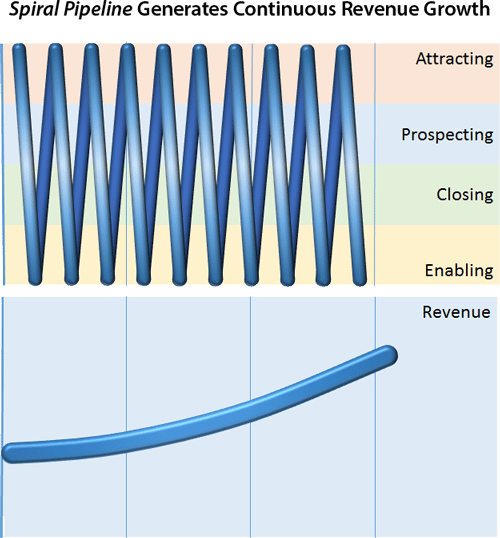It’s time to reframe how we think about closed business. That’s the key to the second of three steps you need to take to build your spiral pipeline for sales and prospecting.
This step involves participating post-sale: staying on the ground and being available even after the sale is closed. What I’m saying is that I would like you to redefine closing: A closed sale only happens when the customer starts using your product.
It’s important to do this for two reasons. One, because this is where you prove your added value to your customer—that you’re more than just someone who closes the sale and moves on. And two because the faster your customer is enabled (starts using your product) the happier they are and the stronger advocate they become.
Actions speak louder than words.
As sellers, nobody has a more vested interest in getting our customers to start using the products and services we sell. However, it’s not enough to just promise a level of commitment. You have to show it. That’s why it’s incumbent on us to stay in touch and ensure each implementation goes smoothly. People remember what we do far more than what we say.
Avoid final-yard fumbles.
Beware! All your hard work that goes into creating a great buying experience can be annihilated at the final-yard before the finish line, just by having an implementation that doesn’t work according to plan. When that happens, you can only make things right if you’re already on the ground and ready to respond. Otherwise, you’ll be playing catch-up, putting in double the amount of time to get half as good results. Make time for this.
Little things matter.
Participating post-sale doesn’t have to demand much of your time to be done successfully. It could be as simple as adding a short phone call to your weekly schedule to review each project with installation staff, and providing a quick update to your customers. Little gestures like that can make a big difference: both in terms of what the buyer sees, and in how your sale gets implemented smoothly.
For example, when I was with Open Text I routinely attended the kick off meetings for our software installation projects. This enabled me to meet new contacts who would be using the product, leaders who would be leading the teams and advocating on our products behalf, and department heads who were responsible for additional projects that we could participate in. When I attended these meetings I was not only able to act as a second set of eyes to our project managers, I was able to spot new opportunities for up sell and cross sell before the original project was completed!
Learn valuable new things.
Staying on the ground can also be an opportunity to discover new business problems that your customer has—the kind that might not have come up before closing, because they weren’t directly related to the sale. The more time you get to spend with a customer, the more opportunities you have to learn from them. Those are growth opportunities, which I’ll cover in more detail next in the final instalment in this series.
Stop thinking your job is done when the contract is signed. Stay on the ground. Remain active even after the deal is closed. It’s a small investment of time that can see you reaping some lucrative benefits.




